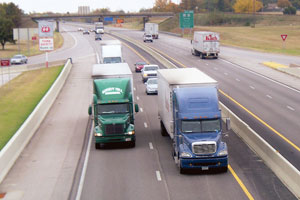Trucks Involved in Fatal Crashes Rise 3% in 2011, FMCSA Says

The yearly number of large trucks involved in fatal crashes is on the rise again after nearly a decade of declining, according to the most recent data from the Federal Motor Carrier Safety Administration.
In 2011, 3,608 large trucks were involved in fatal crashes, a 3% increase over 2010 — and a 12% increase over 2009. Still, the number shows safety has improved from a decade ago, with 25% fewer fatal crashes involving large trucks than in 2001, according to data released Oct. 31 in FMCSA’s annual Large Truck Crash Overview report.
In 2011, 3,757 people were killed and 80,000 injured in collisions involving large trucks, defined as a truck with a gross vehicle weight rating of more than 10,000 pounds, according to the report. Fourteen percent of those killed and 25% of those injured were occupants of the truck.
Truck drivers were more likely than drivers of smaller vehicles to comply with seat belt laws and less likely to be under the influence of drugs or alcohol. In fatal crashes, 83% of truck drivers were reported by police to be wearing their seat belts. That’s compared with 65% of those behind the wheel in passenger vehicles, FMCSA reports.
Only 2.5% of truck drivers in fatal crashes had a blood-alcohol content of 0.01% or greater. In 1% of fatal collisions, the driver’s blood-alcohol level was 0.08% or higher. FMCSA can pull a driver from service for a blood trace of alcohol, according to the report.
A total of 3,341 fatal crashes involved trucks, up from 3,261 in 2010. The number of large trucks in fatal crashes per 100 million vehicle miles traveled also increased from 1.22 in 2010 to 1.35 in 2011.
The FMCSA data also show:
- Most collisions occurred during daylight hours — 65% of fatal crashes and 78% of nonfatal crashes happened between 6 a.m. and 6 p.m.
- In fatal crashes involving large trucks, driver-related factors were recorded for 34% of the drivers. Speed was the top driver-related factor (8%), followed by distraction/inattention (6%), impairment (4%), failure to stay in the proper lane (4%) and blocked vision (3.5%).
- Tractors pulling a semi-trailer accounted for 61% of large trucks involved in fatal crashes and 47% of those in nonfatal collisions.
- Weather played a role in 12% of fatal and nonfatal collisions, with rain the most common factor.
- Passenger vehicles were responsible for 89% of head-on collisions and 74% of rear-end crashes.
- There were 174 large trucks involved in fatal work zone crashes.

